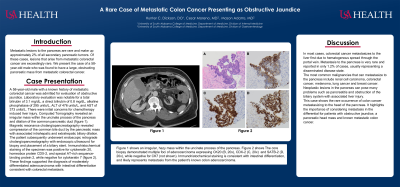Tuesday Poster Session
Category: Biliary/Pancreas
P3581 - A Rare Case of Metastatic Colon Cancer Presenting as Obstructive Jaundice
Tuesday, October 29, 2024
10:30 AM - 4:00 PM ET
Location: Exhibit Hall E

Has Audio
- HD
Hunter Chance Dickson, DO
USA Health, University of South Alabama
Mobile, AL
Presenting Author(s)
Hunter Chance Dickson, DO1, Gannon J. Ray, MD2, Cesar Moreno, MD1, Mason G. Adams, MD2
1USA Health, University of South Alabama, Mobile, AL; 2University of South Alabama College of Medicine, Mobile, AL
Introduction: Metastatic lesions to the pancreas are rare and make up approximately 2% of all secondary pancreatic tumors. Of these cases, lesions that arise from metastatic colorectal cancer are exceedingly rare. We present the case of a 58-year-old male who was found to have a large, obstructing pancreatic mass from metastatic colorectal cancer.
Case Description/Methods: A 58-year-old male with a known history of metastatic colorectal cancer was admitted to our hospital for evaluation of abnormal labs obtained at a routine oncology appointment. Laboratory evaluation was notable for a total bilirubin of 3.1 mg/dL, a direct bilirubin of 0.8 mg/dL, alkaline phosphatase of 295 units/L, ALT of 476 units/L, and an AST of 373 units/L. There were initial concerns for chemotherapy induced liver injury. Computed tomography revealed an irregular mass within the uncinate process of the pancreas and dilation of the common pancreatic duct. Further imaging via magnetic resonance cholangiopancreatography revealed compression of the common bile duct by the pancreatic mass with associated intrahepatic and extrahepatic biliary dilation. The patient subsequently underwent endoscopic ultrasound with biopsy of the mass and then endoscopic retrograde cholangiopancreatography with biliary stent placement. Immunohistochemical staining of the specimen was positive for cytokeratin 20, homeobox protein CDX-2, and special AT-rich sequence-binding protein 2, while negative for cytokeratin 7. These findings supported the diagnosis of moderately differentiated adenocarcinoma with intestinal differentiation consistent with colorectal metastasis.
Discussion: In most cases, colorectal cancer metastasizes to the liver first due to hematogenous spread through the portal vein. Metastasis to the pancreas is very rare and reported in only 1.2% of cases. The most common malignancies that can metastasize to the pancreas include renal cell carcinoma, colorectal cancer, melanoma, lung cancer and breast cancer. Neoplastic lesions in the pancreas can pose many problems such as pancreatitis and obstruction of the biliary system with associated liver injury. This case shows the rare occurrence of colon cancer metastasizing to the head of the pancreas. It highlights the importance of considering metastasis in the differential for patients with obstructive jaundice, a pancreatic head mass and known metastatic colon cancer.
Disclosures:
Hunter Chance Dickson, DO1, Gannon J. Ray, MD2, Cesar Moreno, MD1, Mason G. Adams, MD2. P3581 - A Rare Case of Metastatic Colon Cancer Presenting as Obstructive Jaundice, ACG 2024 Annual Scientific Meeting Abstracts. Philadelphia, PA: American College of Gastroenterology.
1USA Health, University of South Alabama, Mobile, AL; 2University of South Alabama College of Medicine, Mobile, AL
Introduction: Metastatic lesions to the pancreas are rare and make up approximately 2% of all secondary pancreatic tumors. Of these cases, lesions that arise from metastatic colorectal cancer are exceedingly rare. We present the case of a 58-year-old male who was found to have a large, obstructing pancreatic mass from metastatic colorectal cancer.
Case Description/Methods: A 58-year-old male with a known history of metastatic colorectal cancer was admitted to our hospital for evaluation of abnormal labs obtained at a routine oncology appointment. Laboratory evaluation was notable for a total bilirubin of 3.1 mg/dL, a direct bilirubin of 0.8 mg/dL, alkaline phosphatase of 295 units/L, ALT of 476 units/L, and an AST of 373 units/L. There were initial concerns for chemotherapy induced liver injury. Computed tomography revealed an irregular mass within the uncinate process of the pancreas and dilation of the common pancreatic duct. Further imaging via magnetic resonance cholangiopancreatography revealed compression of the common bile duct by the pancreatic mass with associated intrahepatic and extrahepatic biliary dilation. The patient subsequently underwent endoscopic ultrasound with biopsy of the mass and then endoscopic retrograde cholangiopancreatography with biliary stent placement. Immunohistochemical staining of the specimen was positive for cytokeratin 20, homeobox protein CDX-2, and special AT-rich sequence-binding protein 2, while negative for cytokeratin 7. These findings supported the diagnosis of moderately differentiated adenocarcinoma with intestinal differentiation consistent with colorectal metastasis.
Discussion: In most cases, colorectal cancer metastasizes to the liver first due to hematogenous spread through the portal vein. Metastasis to the pancreas is very rare and reported in only 1.2% of cases. The most common malignancies that can metastasize to the pancreas include renal cell carcinoma, colorectal cancer, melanoma, lung cancer and breast cancer. Neoplastic lesions in the pancreas can pose many problems such as pancreatitis and obstruction of the biliary system with associated liver injury. This case shows the rare occurrence of colon cancer metastasizing to the head of the pancreas. It highlights the importance of considering metastasis in the differential for patients with obstructive jaundice, a pancreatic head mass and known metastatic colon cancer.
Disclosures:
Hunter Chance Dickson indicated no relevant financial relationships.
Gannon Ray indicated no relevant financial relationships.
Cesar Moreno indicated no relevant financial relationships.
Mason Adams indicated no relevant financial relationships.
Hunter Chance Dickson, DO1, Gannon J. Ray, MD2, Cesar Moreno, MD1, Mason G. Adams, MD2. P3581 - A Rare Case of Metastatic Colon Cancer Presenting as Obstructive Jaundice, ACG 2024 Annual Scientific Meeting Abstracts. Philadelphia, PA: American College of Gastroenterology.
